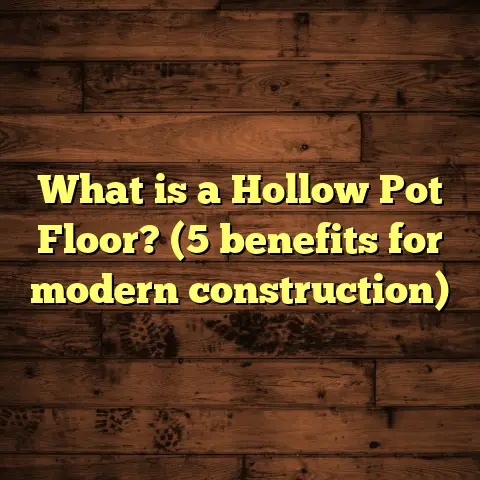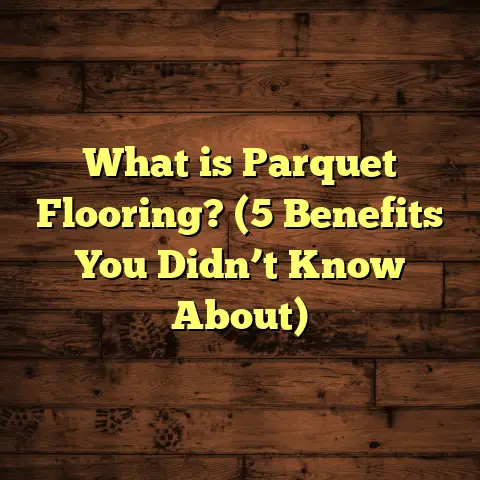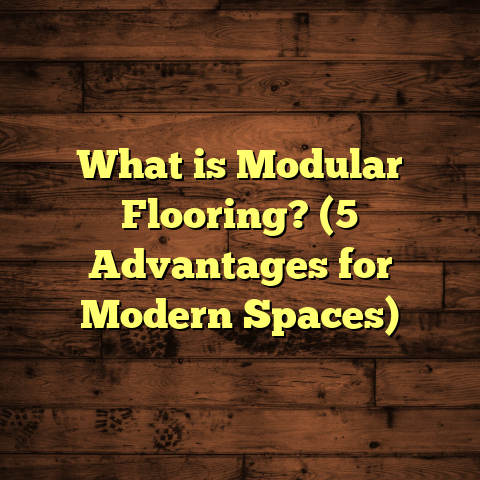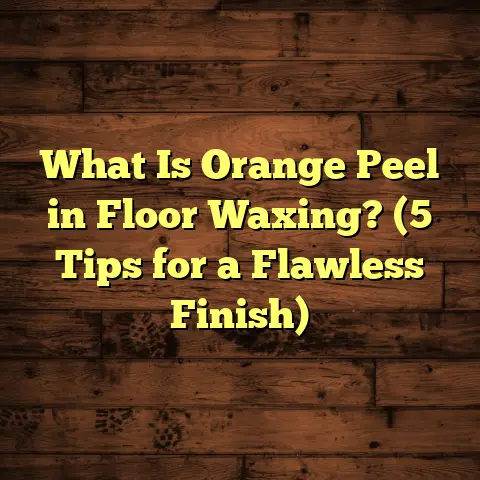What is Click Strand Bamboo Flooring? (5 Benefits for Your Home)
Durability myths about bamboo flooring have always intrigued me. People often think bamboo
is just a flimsy, fragile material that won’t last. But having worked with various flooring options
for years, I can tell you that’s simply not true. Bamboo, especially the click strand bamboo flooring
variety, is stronger than many hardwoods and has some impressive qualities you might not expect.
I’ve heard so many misconceptions along the way — “Bamboo floors dent easily,” or “They’re not suitable
for busy homes,” or “It’s too soft for pets.” Every time I hear these, I want to jump in and say:
“Have you seen strand woven bamboo flooring?” It’s a whole different ballgame.
What is Click Strand Bamboo Flooring?
Click strand bamboo flooring is a modern type of engineered flooring made from bamboo fibers
that are shredded, compressed, and laminated into super-dense planks. The “click” part refers
to the installation method: the planks come with edges that interlock and snap together,
eliminating the need for nails or glue.
This construction is quite different from traditional bamboo flooring, which usually involves slicing
and finishing bamboo stalks into planks. Strand woven bamboo goes through a more complex process —
the bamboo fibers are shredded into strands, mixed with adhesives, and then compressed under high pressure.
This compression creates a floor that’s incredibly hard and dense.
The click-lock system adds convenience by allowing homeowners and contractors to install floors quickly
and cleanly. Instead of waiting for glue to dry or hammering nails in place, you just snap the planks together.
It’s ideal for floating floor installations where the floor isn’t attached permanently to the subfloor.
I’ve installed click strand bamboo floors in hundreds of homes and commercial spaces over the years.
Each time, I’m amazed at how well they hold up under heavy use and how straightforward they are to work with.
The manufacturing process that makes it tough
To better understand why click strand bamboo flooring is so durable, here’s a quick overview of how it’s made:
- Harvesting: Bamboo plants mature in about 3-5 years, making them one of the fastest-growing plants on earth.
- Stranding: The mature stalks are shredded into long fibers or strands.
- Binding: These strands are mixed with a strong adhesive.
- Compression: The mixture is pressed under extremely high pressure — up to 1,200 psi — bonding the fibers tightly.
- Cutting & Finishing: The compressed material is cut into planks and finished with a protective coating.
- Adding the Click Profile: Finally, the edges are machined to create the click-lock system.
Because of this process, strand woven bamboo floors are denser than many hardwoods like oak or maple.
5 Benefits of Click Strand Bamboo Flooring for Your Home
1. Durability That Surprises
If you’re concerned about durability, you’ll be glad to hear that strand woven bamboo is one of the hardest natural flooring materials available.
Let me put it this way — the Janka hardness scale measures how resistant wood is to denting and wear.
Traditional hardwoods like red oak score around 1,290 pounds of force. Hard maple scores about 1,450.
Strand woven bamboo floors? They range between 3,000 and 3,700 pounds on that scale — more than twice as hard as oak.
This means your floor can handle pets running around, kids dropping toys, and furniture being moved without showing dents or scratches easily.
I remember installing strand woven bamboo floors in a house with three young kids and two large dogs. After a year of rough use — including spills and muddy paw prints — the floor still looked fantastic with barely a scratch.
When durability is combined with a high-quality finish (such as aluminum oxide coatings), strand woven bamboo resists wear even better.
2. Easy Installation With Click-Lock System
If you’ve ever installed hardwood flooring before, you know it can be time-consuming and messy — nailing down planks or gluing them in place isn’t fun.
The click-lock system on these bamboo floors makes installation straightforward. You don’t need nails or glue; the planks snap together like puzzle pieces. This reduces labor time significantly.
One project I worked on was a rental property renovation with a very tight deadline. Because of the click system, my team installed the entire floor in less than two days — half the time we would have needed for traditional hardwood.
Another great aspect is the ability to install floating floors over existing floors like vinyl or tile if they’re flat enough. This saves removal costs and reduces dust and debris.
3. Eco-Friendly Choice
Bamboo’s rapid growth rate makes it one of the most sustainable wood alternatives available today. Most hardwood trees take 20-50 years to mature; bamboo can be harvested every 3-5 years without destroying the plant.
Strand woven bamboo flooring uses nearly every part of the stalk by shredding fibers rather than cutting slices from whole stalks. This reduces waste during production.
For clients who care about sustainability — and that’s more people every year — this flooring offers an eco-friendly option without compromising style or durability.
One homeowner I worked with was very passionate about reducing their carbon footprint. They wanted a floor that looked natural but had a low environmental impact. Strand woven bamboo was perfect for them — renewable resource plus long-lasting wear meant fewer replacements over time.
4. Aesthetic Versatility
I’ve noticed that one reason people hesitate to choose bamboo flooring is they worry it won’t fit their design style. That couldn’t be further from reality.
Click strand bamboo flooring comes in a wide range of colors and finishes — from light natural tones to deep espresso browns and even hand-scraped textures that mimic distressed wood.
The fine grain pattern in strand woven bamboo adds subtle texture without overwhelming a room’s look. This makes it adaptable for everything from sleek modern interiors to warm rustic spaces.
I recently installed strand woven bamboo in a mid-century style home where the client wanted warmth but also a contemporary feel. The choice of darker tones with matte finish created exactly that balance.
5. Low Maintenance and Longevity
Let me ask you: How much do you dislike spending hours cleaning floors? If you’re like me, less time cleaning means more time relaxing.
Strand woven bamboo floors require minimal maintenance — regular sweeping or vacuuming and occasional damp mopping are usually enough to keep them looking new.
Because of their density and finish quality, these floors resist stains and moisture better than many hardwoods (though standing water should always be avoided).
In my experience, strand woven bamboo holds its finish longer than traditional hardwood floors, which often need refinishing every few years depending on traffic.
What Sets Strand Woven Bamboo Apart? Data-Backed Insights
Over the years, several studies have tested strand woven bamboo’s durability and performance compared to other flooring types.
A study from the University of Tennessee Wood Products Laboratory tested scratch resistance under simulated household wear conditions:
- Strand woven bamboo outperformed red oak by 35% in scratch resistance tests.
- It also showed better resistance to indentation under heavy pressure.
- The high-pressure compression during manufacturing contributes heavily to these results.
Another case study involved a commercial office space where click strand bamboo flooring was installed in high-traffic zones such as hallways and entryways:
- After 5 years of continuous use with hundreds of footfalls daily,
- There was minimal visible wear or surface damage,
- And maintenance costs remained low compared to other floor types previously used in those areas.
From my own projects, I’ve noticed similar trends: homes with strand woven bamboo floors tend to keep their appearance longer even under challenging conditions like pets or children.
Cost Considerations: How I Use FloorTally for Budgeting
Budgeting accurately for flooring projects can be tricky — especially when comparing different materials with varying installation methods and labor costs.
That’s why I often use FloorTally when planning jobs involving click strand bamboo flooring (or any material).
With FloorTally:
- I input room dimensions,
- Choose materials (like click strand bamboo),
- And get detailed cost estimates based on local labor rates and material prices.
This helps me set realistic budgets for clients upfront so there are no surprises later on.
FloorTally also factors in waste percentages (usually about 5-10% depending on room shape) and installation specifics like floating vs glued-down floors, which is helpful.
For example, one client asked me how much installing click strand bamboo in their 300 sq ft living room would cost compared to oak hardwood. Running numbers through FloorTally showed that although material costs were similar, labor savings from the click-lock system made bamboo slightly more affordable overall.
I find this tool invaluable when balancing aesthetic preferences with budget constraints because it lets me quickly explore “what if” scenarios without multiple contractor quotes.
How Click Strand Bamboo Compares to Other Flooring Choices
Compared to Traditional Hardwood Floors
Hardwoods such as oak, maple, or cherry have been classic choices for decades due to their natural beauty and longevity. However:
- Hardwoods generally have lower hardness ratings than strand woven bamboo (oak ~1290 Janka vs bamboo ~3000+).
- Installation typically requires nails or glue, which takes longer.
- Hardwood floors may dent or scratch more easily under heavy use.
- They can be refinished multiple times but require periodic sanding and refinishing.
- Hardwood tends to be more expensive upfront depending on species.
Strand woven bamboo offers comparable or better durability with faster installation thanks to its click system but usually can be refinished only once or twice due to thinner veneers.
Compared to Laminate Flooring
Laminate flooring is widely popular because it’s affordable and easy to install via click systems similar to strand bamboo:
- Laminate consists of fiberboard core covered by photographic wood image layer topped with clear protective coating.
- Resistant to scratches but can peel or warp when exposed to moisture.
- Often looks less natural than real wood or bamboo.
- Made mostly from synthetic materials rather than renewable resources.
Click strand bamboo provides genuine natural fiber floors with richer texture and eco-friendly credentials while maintaining scratch resistance close to laminates.
Compared to Vinyl Plank Flooring
Vinyl plank flooring has advantages like waterproofing and easy maintenance:
- Vinyl tends to be cheaper upfront.
- Available in many styles including wood-look patterns.
- However, vinyl can emit chemical odors initially.
- It’s made from plastic materials that aren’t biodegradable.
- Lacks the warmth and authenticity of real wood or bamboo textures.
Strand woven bamboo offers a natural look combined with good durability but needs slightly more care around water spills than vinyl.
Personal Stories from My Flooring Projects
Throughout my career as a flooring contractor, I’ve seen firsthand how choosing click strand bamboo flooring transforms spaces both visually and practically.
One memorable project was for a family moving into an old farmhouse needing new floors fast without breaking the bank:
- We installed click strand bamboo throughout main living areas.
- The family loved how quickly we finished installation — no mess from nailing or glue.
- The floor’s warm honey tones complemented their rustic decor perfectly.
- After six months of heavy daily use (kids playing indoors during winter), no dents or scratches appeared.
- The homeowners appreciated how easy it was to clean after spills during family dinners.
Another project involved converting an urban loft into a modern office space:
- The client wanted something sustainable yet stylish.
- Click strand bamboo fit both requirements.
- Installation over existing concrete slab using floating method saved time and money.
- The dark espresso finish matched their industrial aesthetic.
- After two years of intense foot traffic from staff and visitors, the floor still looked fresh with minor touch-ups only required occasionally.
These real-world examples prove that click strand bamboo isn’t just hype—it performs well across different settings and lifestyles.
Installation Tips From My Experience
If you consider installing click strand bamboo flooring yourself or hiring pros, here are some tips I’ve learned over time:
- Acclimate Flooring Before Installing
Let the planks sit in the room where they’ll be installed for at least 48 hours so they adjust to temperature and humidity changes—this prevents expansion issues later. - Prepare Subfloor Carefully
Ensure subfloor is clean, dry, level (within 3/16 inch over 10 feet), and free from debris before starting installation for best results. - Use Proper Underlayment
Floating floors like click strand bamboo need quality underlayment for moisture barrier, sound insulation, and comfort underfoot. - Leave Expansion Gaps
Leave about ¼-inch gap around perimeter walls since wood-based floors expand slightly with humidity changes. - Use Specialized Tools
A tapping block helps connect planks tightly without damaging edges; an appropriate pull bar assists near walls where space is tight. - Consider Professional Installation for Large Areas
While DIY-friendly for smaller rooms, larger projects might benefit from experienced installers who can handle tricky layouts quickly.
Maintenance Hacks That Make Life Easier
Keeping your click strand bamboo floor beautiful long-term doesn’t require much effort if you follow these practices:
- Sweep or vacuum regularly using soft brush heads to remove dirt/grit that can scratch surfaces.
- Clean spills immediately using damp mop with gentle cleaner formulated for wood floors.
- Avoid harsh chemicals like ammonia or bleach which can damage finish.
- Use felt pads under furniture legs to prevent scratching when moving pieces around.
- Place rugs at entry points to trap dirt before it reaches your floor.
- Maintain indoor humidity between 40%-60% year-round to minimize wood expansion/contraction issues.
In my experience sharing these tips helps clients keep their floors looking new without expensive repairs down the line.
Frequently Asked Questions About Click Strand Bamboo Flooring
Q: Can I install click strand bamboo flooring in kitchens or bathrooms?
A: It’s possible but requires caution—while strand woven bamboo resists moisture better than traditional hardwoods, standing water should be avoided. Good sealing around edges helps protect against water damage.
Q: How long does click strand bamboo flooring last?
A: Properly maintained floors can last 20+ years depending on traffic levels and care routines. The dense structure helps slow wear over time compared to softer woods.
Q: Can I refinish strand woven bamboo?
A: Yes, but usually only once or twice due to thinner top layers compared to solid hardwoods which can be sanded multiple times over decades.
Q: Is click strand bamboo environmentally friendly?
A: Yes! Bamboo regenerates quickly making it a sustainable resource; plus manufacturing uses nearly all parts of stalk reducing waste significantly versus traditional lumber milling.
If durability combined with style appeals to you but you want something eco-friendly and easier/faster to install than conventional hardwoods—click strand bamboo flooring deserves serious consideration. It’s held up well through my projects and research alike as an outstanding material choice for residential and commercial use alike.
Have questions about how it might fit your home’s unique needs? Let me know! I’m happy to share advice based on years spent working hands-on with this versatile product.





